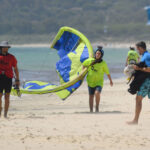Wingfoiling vs Kitesurfing: Exploring the Differences
For thrill-seekers and water sports enthusiasts Girls, the debate between wingfoiling and kitesurfing is a common one. Both sports offer exhilarating experiences on the water, but they differ in equipment, technique, and overall experience. In this blog, we’ll explore the key differences between wingfoiling and kitesurfing to help you determine which one may be better suited to your preferences and skill level.
Wingfoiling:
Wingsurfing, also known as wingfoiling, is a relatively new water sport that involves riding a small, handheld wing while standing on a big board. The wing is controlled using hand-held handles or a bar, and riders harness the power of the wind to propel themselves across the water. Wingfoiling offers a unique sensation of flying over the water’s surface, and its simplicity and versatility make it appealing to beginners and experienced riders alike.
Kitesurfing:
Kitesurfing, on the other hand, involves riding a small, inflatable kite attached to a harness, which is used to generate power and propel the rider across the water on a board. Kitesurfing requires more technical skill and coordination than wingfoiling, as riders must learn to control the kite’s power and direction while simultaneously manoeuvring the board through the water. However, once mastered, kitesurfing offers unparalleled speed, agility, and adrenaline-pumping excitement.
Key Differences:
Equipment: Wingfoiling requires only a wing and a board and with more experience a foil board, making it a more minimalist and portable option compared to kitesurfing, which requires a kite, harness, control bar, lines, and board.
Learning Curve: Wingfoiling is generally considered easier to learn than kitesurfing, as it requires less technical skill and coordination. Beginners can typically get up and riding within a few hours or days of instruction, whereas kitesurfing may require several days or weeks of practice to master.
Wind Conditions: Wingfoiling is more forgiving in lighter wind conditions, making it suitable for a wider range of weather conditions compared to kitesurfing, which requires stronger and more consistent winds to generate power.
Manoeuvrability: Kitesurfing offers greater manoeuvrability and versatility compared to wingfoiling, allowing riders to perform a wide range of tricks, jumps, and turns on the water. Wingfoiling, while still capable of impressive manoeuvres, is generally more limited in its range of motion and aerial capabilities.
Which One is Better?
The answer to this question ultimately depends on your personal preferences, skill level, and the conditions in which you plan to ride. If you’re looking for a simple, accessible, and portable water sport that offers a unique sensation of flight, wingfoiling may be the better option for you. On the other hand, if you crave speed, adrenaline, and the thrill of mastering a technical challenge, kitesurfing may be more your speed.
At Lenguaventura summer camp in Spain, we offer a unique opportunity for teens to experience the excitement of both wingfoiling and kitesurfing. Our experienced instructors provide comprehensive instruction and guidance, allowing campers to develop their skills and confidence on the water. Whether you’re drawn to the simplicity of wingfoiling or the adrenaline rush of kitesurfing, our camp has something for everyone. Join us at Lenguaventura and discover the transformative power of outdoor sports for teens!









